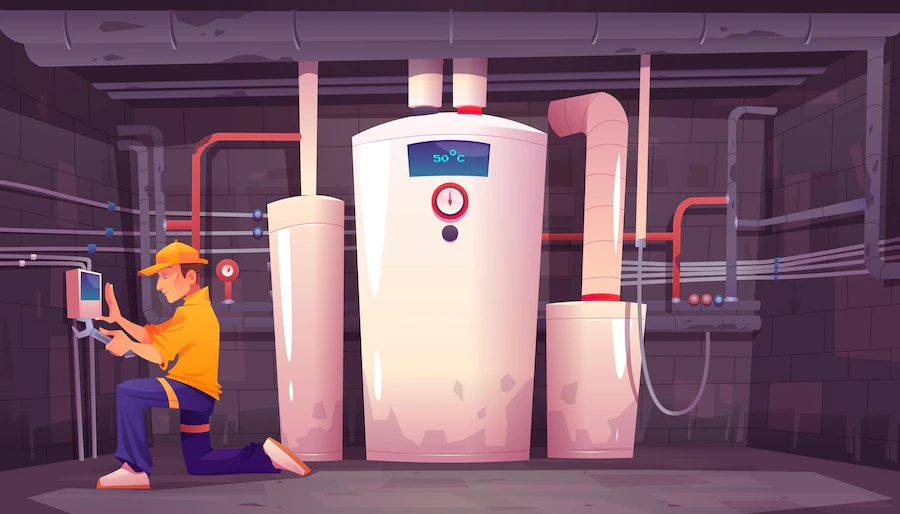What to Do If the Heat is Not Working?
The first step to take if your heating system isn’t working is to check to see if the furnace is turned on. If it’s on, check to see if there’s a leak in the attic or a faulty heating element. If there’s no leak, try to isolate the problem or contact a heating repair service.
What You Can Do If The Heat Is Not Working?
Check if your furnace is turned on.
- One of the first steps in troubleshooting your furnace is to check the furnace’s power switch.
- This small, plastic, or bright-colored switch is located on the furnace. If the switch is in the “off” position, you need to flip it back to “on” to power the furnace.
- If the power switch is still in the “off” position, you should check your furnace’s circuit breaker, which is located in the home’s breaker panel.
If the problem persists, you may need to replace the furnace.
- Depending on the model, a new unit may need to be purchased. The repair process is time-consuming, and it can be more cost-effective to call an HVAC company.
- As a precaution, it’s best to check your furnace at least one month before the start of the cold season.
If the problem persists
- You should check the furnace’s “reset” button, located near the motor housing.
- If this method fails, wait 30 minutes, and press the button a second time.
- If this doesn’t work, consult the owner’s manual to determine what the problem is.
- If you don’t have an owner’s manual for your furnace, you can also try removing the front panel.
- Look for the ignitor and the sensor. If the sensor is dirty, use a screwdriver with a proper head to remove it.
If your furnace isn’t on, the utility company may be experiencing an interruption in service near your home. If the gas supply is interrupted, check your furnace’s gas valve shut-off switch to make sure it is set to “on.” Also, check the thermostat to ensure that it’s set at the desired temperature.
Often, problems with furnaces can be simple to fix –
- A dirty filter or a flipped switch may be the issue. It’s also possible that a dirty flame sensor is preventing your furnace from turning on.
- A dirty flame sensor can accumulate dust, carbon deposits, or other contaminating materials, which prevents the flame sensor from sensing a flame.
- This can cause the furnace to shut down to protect your home from dangerous fires.
- If you find your furnace isn’t on, you can try lighting the pilot light. If this doesn’t fix your problem, you need to call a professional furnace repair company to diagnose the problem.
Check for leaks in your attic.
If you’re having trouble with the heat, there could be air leaks in your attic. This problem is virtually invisible, but it can be very expensive to fix. Look for areas of dark or frosty insulation. When the temperature drops, warm air condenses on the cold attic air, making it appear frosty. You can check for these leaks by using a dollar bill or a piece of paper to test for drafts. If the paper moves, the leaks are likely located in the attic.
If you find a leak, you should immediately fix it to save money on energy bills. Sometimes attic leaks are hidden under the insulation. A floor plan will help you determine where they’re most likely to be. You can also check for the location of the furnace and its flue.
If you notice a leak, you can use caulk to plug the openings. Alternatively, you can use foam gaskets to seal gaps around electrical outlets. Air leaks in the attic are a major source of heat loss. Even if your attic is properly insulated, there are still openings that let cold air in. Using air sealing techniques, you can stop major air leaks and prevent minor ones.
Air leaks can also affect the air quality of your home. When you seal these leaks, you can save up to 15% on your heating and cooling bills. Moreover, if you’re looking for ways to make your attic more energy efficient, you can also hire a qualified technician to perform a blower door test and conduct a home energy audit.
Checking for leaks in your attic is a quick way to determine if there are any holes or cracks in the insulation. If you have the proper equipment, you can use a flashlight to check for gaps and leaks. In order to avoid injury, always wear breathing protection while inspecting the attic.
You can also check for other issues, such as poor ventilation. Proper ventilation is crucial to preventing mold and moisture buildup and making your home more energy efficient. It is also helpful to have regular inspections to find issues before they become bigger ones.
Alongside checking ventilation. Scheduling a professional tune-up helps ensure furnace components are inspected and cleaned before small issues become unsafe or costly. Routine checks commonly identify a dirty flame sensor, a failing ignitor, or airflow restrictions that reduce efficiency and indoor air quality. If you’d rather have a licensed technician handle seasonal inspections or urgent repairs, consider a local furnace service that documents findings and recommends only necessary fixes. Preventive maintenance like this often extends system life and reduces the chance of unexpected breakdowns in cold weather.
Check for a faulty heating element.
If the heat is not working in your appliance, you may have a faulty heating element. These heating elements are fairly simple but can burn out or break. Luckily, they can be repaired or replaced. However, if you are unsure about how to replace them, you should try the following steps to determine the cause of your appliance’s problem.
The first thing you should try is to test the element’s resistance. You can use a multimeter to do this. Simply touch the probe to the screw on the element. If the probe moves, the heating element is faulty. To test the other elements, follow the same instructions.
Another way to determine whether your heating element is faulty is to check the pilot light. If you see that the pilot light is lit, then your heating element is functioning properly. If it is still not working, then you may need to have it repaired by a professional. In case of a malfunctioning heating element, you can contact a local electrician to determine the cause.
If you cannot find a faulty heating element on your own, the element may be clogged with scale and minerals. When the elements are clogged with minerals, they become less efficient and may even break. You can try to clean them by using a multimeter. Make sure that the resistance reading of the heating element is between 10 and 30 ohms. If the resistance reading of the heating element is less than 10 ohms, it is most likely that your heating element is faulty.
Another simple way to test if the heating element is clogged is to use a non-contact voltage tester. This tester is shaped like a pen and lights up when it is near a live wire. Place the tester near the wires connecting the heating element and thermostat to see if it lights up.
You can also test the element’s continuity by using a multimeter. If the element does not light up or buzz, it is most likely faulty. If the element is damaged, it should be replaced.
Check for a gas leak.
Gas leaks are Thed can cause a lot of damage. If you suspect a leak, you need to evacuate the home and avoid using electrical appliances in the vicinity of the leak. You should never attempt to fix a leak on your own. Always call emergency services if you suspect a leak. Besides, you should avoid doing anything that could ignite the leak. To be safe, check for bubbles around the pipes and the smell of gas. Only when the leak is fixed can you return to your home.
Gas leaks can affect the health of people and animals living in your home. Since natural gas deprives the body of oxygen, it can cause sickness and even death. The Centers for Disease Control and Prevention estimates carbon monoxide causes around 430 deaths every year in the U.S. It is important to maintain regular tune-ups of the HVAC system to prevent gas leaks.
If you smell gas, you should immediately turn off the heat and evacuate the home. Even a small amount of gas can cause an explosion. Therefore, it is important to educate everyone in your household about the dangers of gas leseveral suspect a leak, you should consult a professional.
If you’ve noticed that the heat isn’t working, you should first check the gas valve. Make sure the pilot light is blue. If it’s yellow or orange, it is a sign that you may leak. Call your local gas company immediately. Also, check for strange noises in the furnace.
If the heat is not working, you should immediately shut off the heating system and shut off the gas lines. Gas leaks can be dangerous, so it’s imperative to get them fixed immediately. You should contact your local gas company and HVAC expert if you suspect a leak.
Gas leaks can cause several health problems, including fatality. Because they’re not always immediately visible, they should not be ignored. There are several ways to check for a leak, including testing for a small amount of gas in the air.

















